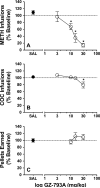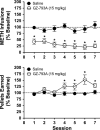The effect of a novel VMAT2 inhibitor, GZ-793A, on methamphetamine reward in rats
- PMID: 21938414
- PMCID: PMC3390966
- DOI: 10.1007/s00213-011-2488-9
The effect of a novel VMAT2 inhibitor, GZ-793A, on methamphetamine reward in rats
Abstract
Rationale: Previous research suggests that the vesicular monoamine transporter-2 (VMAT2) is a novel target for the treatment of methamphetamine (METH) abuse.
Objective: The effects GZ-793A, a novel, selective, and potent lobelane analog, on the rewarding effects of METH, cocaine, and palatable food in rats were determined.
Method: GZ-793A (3-30 mg/kg, s.c.) was administered 20 min prior to each session in which the groups of rats pressed a lever for infusions of METH (0.03 mg/kg/infusion), cocaine (0.3 mg/kg/infusion), or food pellets. Tolerance to repeated GZ-793A (15 mg/kg, s.c. for 7 days) on METH self-administration and food-maintained responding was determined. The ability of increasing doses of METH (0.001-0.56 mg/kg, i.v.) to surmount inhibition produced by GZ-793A (15 mg/kg, s.c.) was determined. Self-administration of GZ-793A (0.01-0.3 mg/kg/infusion, i.v.) was tested as a substitute for METH infusion. GZ-793A (15 mg/kg, s.c.) was administered 20 min prior to METH or saline conditioning in a place preference test.
Results: GZ-793A specifically decreased METH self-administration, without the development of tolerance. Increasing the unit dose of METH did not surmount the inhibition produced by GZ-793A on METH self-administration. GZ-793A did not serve as a substitute for self-administered METH. GZ-793A blocked METH-induced conditioned place preference (CPP) and did not induce CPP alone.
Conclusions: These results indicate that VMAT2 is a viable target for pharmacological inhibition of METH reward and that GZ-793A represents a new lead in the discovery of a treatment for METH abuse.
Figures







References
-
- Anton RF, Moak DH, Waid LR, Latham PK, Malcolm RJ, Dias JK. Naltrexone and cognitive behavioral therapy for the treatment of outpatient alcoholics: results of a placebo-controlled trial. Am J Psychiatry. 1999;156(11):1758–1764. - PubMed
-
- Bardo MT, Bevins RA. Conditioned place preference: what does it add to our preclinical understanding of drug reward? Psychopharmacology (Berl) 2000;153(1):31–43. - PubMed
-
- Beckmann JS, Siripurapu KB, Nickell JR, Denehy ED, Vartak AP, Crooks PA, et al. The pyrrolidine analog of nor-lobelane, cis-2,5-di-(2-Phenethyl)-pyrrolidine hydrochloride, inhibits VMAT2 function, dopamine release, and methamphetamine self-administration in rats. J Pharmacol Exp Ther. 2010;335(3):841–851. - PMC - PubMed
-
- Berridge KC. The debate over dopamine's role in reward: the case for incentive salience. Psychopharmacology (Berl) 2007;191(3):391–431. - PubMed
-
- Bohnen NI, Koeppe RA, Meyer P, Ficaro E, Wernette K, Kilbourn MR, et al. Decreased striatal monoaminergic terminals in Huntington disease. Neurology. 2000;54(9):1753–1759. - PubMed
Publication types
MeSH terms
Substances
Grants and funding
LinkOut - more resources
Full Text Sources
Medical

